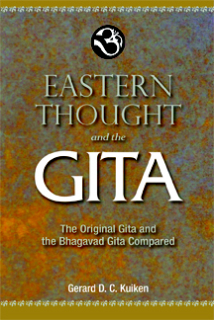
Eastern Thought and the Gita
Praise for
While there have been many translations and studies of the Bhagavad Gita, Gerard Kuiken's is unique inasmuch as it has brought new data from a lost Indonesian source to our attention. This source, which Kuiken terms "The Original Bhagavad Gita," throws the content of the Gita as we know it into a new perspective, opening up new avenues for exploring the history of this text. Kuiken is to be applauded for producing an original and highly readable new translation, which is supplemented with exhaustive notes and lexicography. David Gordon White, J. F Rowny Chair of Comparative Religion, University of California, Santa Barbara, March 2014.
Review
I reviewed the antecedent to this magisterial work, The Original Gita, in 2007. This new book updates and incorporates the earlier one and includes an extra two parts. As before, the book begins with three brilliant short chapters on the background of Indian thought in terms of the nature of thought itself, time and the polarity of life and death. The message of the Gita is that we can become free of pairs of opposites by realising that each pair includes a third element, namely difference. We can become aware that we are unlimited and omnipresent in our essence, even though we are by definition limited by the very nature of existence. Of particular interest is the complementarity between life and death, where physical life turns outwards towards form, while death turns inwards towards the formless. As Swedenborg pointed out 200 years ago, the inside thought is seen as the outside world — we see our own world. All this is explained within the context of reincarnation. The core of the Gita consists of 319 of the 700 verses, which are presented in a new translation and in the context of striving for Oneness. The next part forms a commentary, explaining the content in more detail, and this is followed by and a detailed transliteration with the original Sanskrit and underneath a literal translation and a more fluent expression of this translation. The final part is a Sanskrit dictionary of all the terms used in the Gita, so that the reader can understand the variations of meaning as expressed in the original verses. This is an extraordinary work of scholarship which will fascinate readers of one of the world’s greatest Scriptures. It will take pride of place next to Radhakrishnan’s edition in my library. David Lorimer: Network Review, Journal of the Scientific and Medical Network. No. 107, Winter 2011, p. 66.
Description
Eastern Thought and the Gita consists of five parts. Part One is the same as Part One in The Original Gita, discussing Eastern thought in concise form.
In Part Two, the 209 stanzas of the Original Gita are the same as in The Original Gita, but in the Introduction to Part Two, the date and the origin are compared with the content and the date of the Bhagavad Gita.
In Part Three, comments on the 209 stanzas of the Original Gita are given with a new translation of the core 319 verses of the 700 verses of the Bhagavad Gita that correspond to these 209 verses.
In Part Four, the core 319 Sanskrit verses are given in transliterated form with a word-for-word translation. The new English translation of each Sanskrit verse has been guided by the stanza in the Original Gita. Each chapter starts with a comparison of the content of the whole chapter in the Bhagavad Gita with the content of the corresponding chapter in the Original Gita. In this comparison and in comparing each corresponding verse(s) in the Bhagavad Gita with the stanza in the Original Gita, it is found that there are some differences. They are mostly found in changing abstract forms, such as THAT into Me, Krishna, and by adding devotion to Krishna. This study shows that the connection to the Original Gita can still be found, to a very high degree, in the 319 verses of the Bhagavad Gita.
Part Five is an extensive Sanskrit-English dictionary containing all the Sanskrit words found in the 319 core verses in English alphabetical order. The multiple meanings of the Sanskrit words are given, and also their roots and parts of compounded words. Every reader, without knowledge of the Sanskrit language, can check every choice of any translator of the 319 core verses of the Bhagavad Gita by using this 240-page dictionary, constructed by consulting the various dictionaries of Sanskrit in English, German and French.
The book ends with a bibliography and an index.
A free download of The Original Gita Aphorisms found in Part Two in English is available under the heading 'publications' in the English section of 'Downloads' in English and Sanskrit.